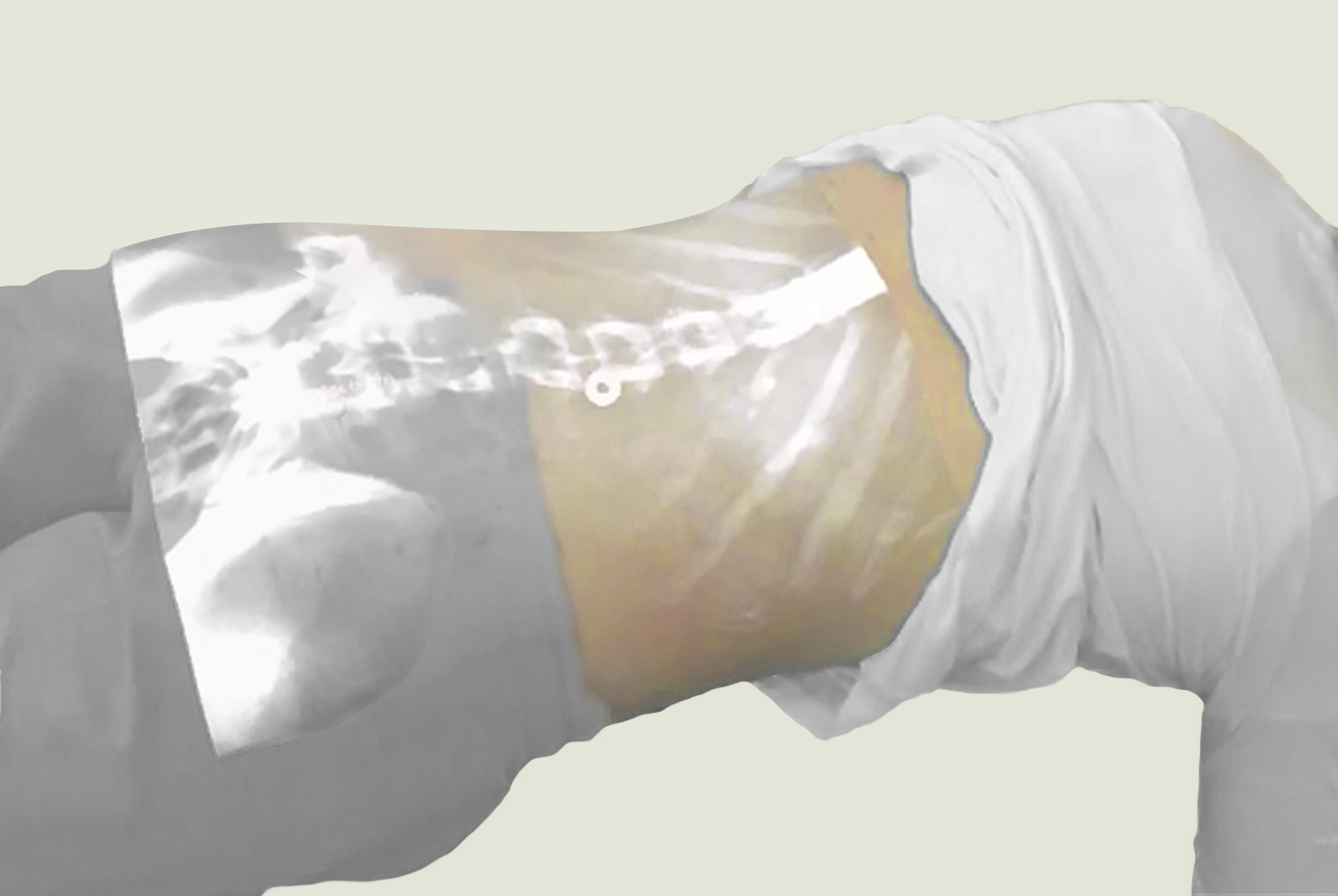stories on progressBreakthrough augmented reality medical tool.
May 10, 2021

images | above + below
The Project DR augmented reality (AR) system projects a diagnostic medical image of a spinal injury directly onto the patient’s skin. The 3D overlay effect is visible using virtual reality eyewear goggles called a headset — or hand-held glass panels specialized for AR display.

— contents —
~ story
~ featurettes
~ webpages
~ reading
— story —
New technology — called Project DR — is bringing the power of augmented reality into clinical research + hospitals. The system projects medical images — like CT scans or MRI scans — directly onto a patient’s skin. This gives physicians a 3D visual of the patient from the outside + inside. With both views, a physician can virtually see inside the patient — since the images are mapped to the patient’s body from above.
The project was created by researchers at the Univ. of Alberta, in Canada.
How it functions.
ProjectDR uses a system called motion capture. Special markers are placed on the patient’s body. The space is flooded with infrared light that bounces off the markers. The computer system uses infrared cameras (that’s a type of thermal camera) that can see the markers — and keep-up with them as they move.
By tracking the body markers, Project DR knows just where to project the medical scan images onto the patient’s body. It maps the medical scans to the anatomical markers. This creates an effect — like you’re looking inside the human body. And it can follow the patient moving — so the scans can be projected continuously.
To understand a motion capture system — and for a primer on virtual reality, augmented reality, and mixed reality — see the good featurettes below. They show actual footage of virtual experiences + 3D demos — explaining this tech.
The project’s supervising researcher Pierre Boulanger PhD said:
Our Project DR system is an augmented reality (AR) software platform that projects medical diagnostic images onto the skin surface of a patient.
This system corrects the image if there’s distortion from skin contours — and automatically adjusts to fit the size + shape of the patient. Our software uses 2D or 3D diagnostic image formats. And the output can be viewed through see-through or projected displays.
Benefits for the future.
Some applications for this AR system include:
- medical education
- medical research
- physio-therapy
- laparoscopic surgery
- surgical planning
Project DR can also project limited sections of body scans — for example: only lungs, skeleton, or blood vessels — depending on what a physician wants to examine.
1. | quote
name: Pierre Boulanger PhD
bio: project researcher
We demo Project DR in an operating room — in a surgical simulation lab — to test the pros + cons in surgeries. We’re also doing pilot studies to test this system for teaching physical therapy techniques. Next we’ll conduct real-life surgical pilot studies.
2. | quote
name: Ian Watts
bio: research team member
We wanted to create a system that would show clinicians a patient’s internal anatomy — within the context of the body. The difficult part is having the image track properly on the patient’s body — even as they shift + move. I’m improving the system’s automatic calibration and adding depth sensors.
featurettes
1. |
school: the Univ. of Alberta
title: Project DR demo
project: Project DR | visit
watch | featurette
— about —
Project DR is an augmented reality (AR) system that enables medical images — such as CT scans + MRI data — to be displayed directly on a patient’s body, in a way that moves as the patient does.
presented by
school: the Univ.of Alberta
web: home ~ main channel ~ science channel
motto: Whatsoever things are true.
2. |
school : Full Sail Univ.
title: What is motion capture?
watch | featurette
— about —
From films + video games — to the military, sports, and medical fields — motion capture is used to record the movement of objects or people. And create 3D animated models. Teacher Tyrone Jordan demos the basics of motion capture.
presented by
school: Full Sail Univ.
web: home ~ channel
motto: Explore degrees in entertainment, media, arts, and tech.
3. |
company: SimpliLearn
web: home ~ channel
motto: We transform lives by empowering people via digital skills.
title: The rise of tech: VR (virtual reality), AR (augmented reality), and MR (mixed reality).
watch | featurette
These immersive reality systems: VR (virtual reality), AR (augmented reality), and MR (mixed reality) — are amongst the fastest-growing computer technologies today, involving both hardware + software. In a nutshell, immersive tech creates or extends our sensory experience.
It immerses the user in a digital environment — that’s visual, auditory, and even tactile. It can be a pure fantasy world, or a realistic model, or overlays that appear on top of the actual world around us. This tech is gaining momentum and has lots of applications. Watch this video to understand what immersive tech is — and how it’s useful in re-imagining our future.
presented by
company: SimpliLearn
motto: We transform lives by empowering people via digital skills.
web: home ~ channel
— webpages —
name: Pierre Boulanger • PhD
web: home
reading
1. |
from: New Atlas
title: ProjectDR allows doctors to see into patients’ bodies
read | story
Imagine if doctors could see through a patient’s skin. And their perspective of the underlying bones + organs changed accordingly — as the person moved around. That’s what scientists at the Univ. of Alberta in Canada have developed. It’s still in the experimental phase, and is called ProjectDR.
presented by
New Atlas | home ~ channel
tag line: Extraordinary ideas moving the world forward.
2. |
from: Futurism
title: Doctors can now use augmented reality to peek under a patient’s skin
read | story
A new tech takes some of the guesswork out of medicine.
presented by
Futurism | home ~ channel
tag line: Wonder what’s next.
Singularity grp. | home ~ channel
tag line: We prepare you to seize exponential opportunities.
3. |
from: the Richard van Hooijdonk blog
title: ProjectDR uses new augmented reality tech to let doctors see through your skin
read | story
watch | featurette
A pilot program at the Univ. of Alberta brings digital magic to the operating room — so surgeons can see inside their patients before they make the first incision. The researchers have developed a system called ProjectDR, a revolutionary augmented reality tech for medical teaching + patient care.
presented by
the Richard van Hooijdonk blog | home ~ channel ~ blog
tag line: A keynote speaker, trend-watcher, and futurist.
— notes —
AR = augmented reality
VR = virtual reality
CT scan = computed tomography scan
MRI scan = magnetic resonance imaging scan
* physio-therapy is also called physical therapy
